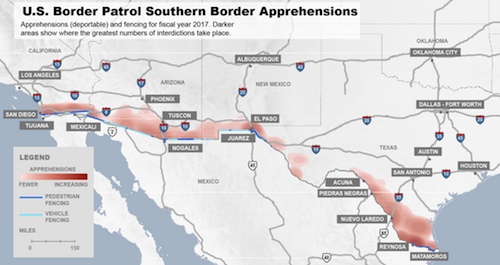
by Tobias Naegele
Illegal border crossings fell to their lowest level in at least five years in 2017, but after plunging through April, the numbers have risen each of the past eight months, according to U.S. Customs and Border Protection (CBP).
Meanwhile, the debate continues: Build a physical wall spanning from the Gulf of Mexico to the Pacific Ocean, add more Border Patrol agents or combine better physical barriers with technology to stop drug trafficking, smuggling and illegal immigration?
Increasingly, however, it’s clear no one solution is right for everyplace. Ron Vitiello, acting deputy commissioner at CBP, said the agency intends to expand on the existing 652 miles of walls and fencing now in place – but not necessarily extend the wall the entire length of the border.
“We’re going to add to fill some of the gaps we didn’t get in the [previous] laydown, and then we’re going to prioritize some new wall [construction] across the border in places where we need it the most,” he said in a Jan. 12 TV interview.
Walls and barriers are a priority, Vitiello said in December at a CBP press conference. “In this society and all over our lives, we use walls and fences to protect things,” he said. “It shouldn’t be any different on the border.… But we’re still challenged with access, we’re still challenged with situational awareness and we’re still challenged with security on that border. We’re still arresting nearly 1,000 people a day.
“So we want to have more capability: We want more agents, we want more technology and we want that barrier to have a safer and more secure environment.”
Among the needs: Relocatable Remote Video Surveillance Systems (R-RVSS) that can be picked up and moved to where they’re needed most as border activity ebbs and flows in response to CBP’s border actions.
CBP mapped its fencing against its 2017 apprehension record in December (see map), finding that areas with physical fencing, such as near the metropolitan centers of San Diego/Tijuana, Tucson/Nogales and El Paso/Juarez are just as likely to see illegal migration activity as unfenced areas in the Laredo/Nueva Laredo area.
Read the complete article at the link below…
Source: govtechworks.com
